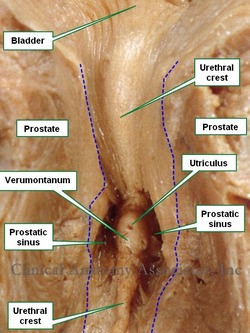
Anterior view of a section of the prostate gland. The blue
dotted line shows the edges of the prostatic urethra
[UPDATED] The [prostatic utricle], also known as "utriculus prostaticus" or "utriculus" is a small 6 mm small dead-end channel found in the male prostatic urethra.
The word [utriculus] is Latin and means "little sac"..
What is interesting about this structure is that it is the embryological remnant in the male of the Müllerian ducts that form the vagina and the uterus in the female. In fact, in some texts the prostatic utricle is referred to as "uterus masculinus". Some researchers differ and point to the fact that this structure may not be a Müllerian duct derivate.
The prostatic utricle is found inside the prostate, forming part of the posterior wall of the prostatic urethra. It is in the upper part of a small mound which is part of the prostatic crest. This mound is called the [colliculus seminalis] or [verumontanum], which is Latin and translates as the "mountain or mound of truth". On the verumontanum are the two slit-like openings of the ejaculatory ducts. Lateral to the verumontanum are the prostatic sinuses, depressions where the prostatic ducts are found.
Sources:
1. "The prostatic utricle is not a M?llerian duct remnant: immunohistochemical evidence for a distinct urogenital sinus origin" Shapiro E, Huang H, McFadden DE, et al. (2004) J Urol 172; 1753–1756
2. "Gray's Anatomy"38th British Ed. Churchill Livingstone 1995
3. "Tratado de Anatomia Humana" Testut et Latarjet 8 Ed. 1931 Salvat Editores, Spain



